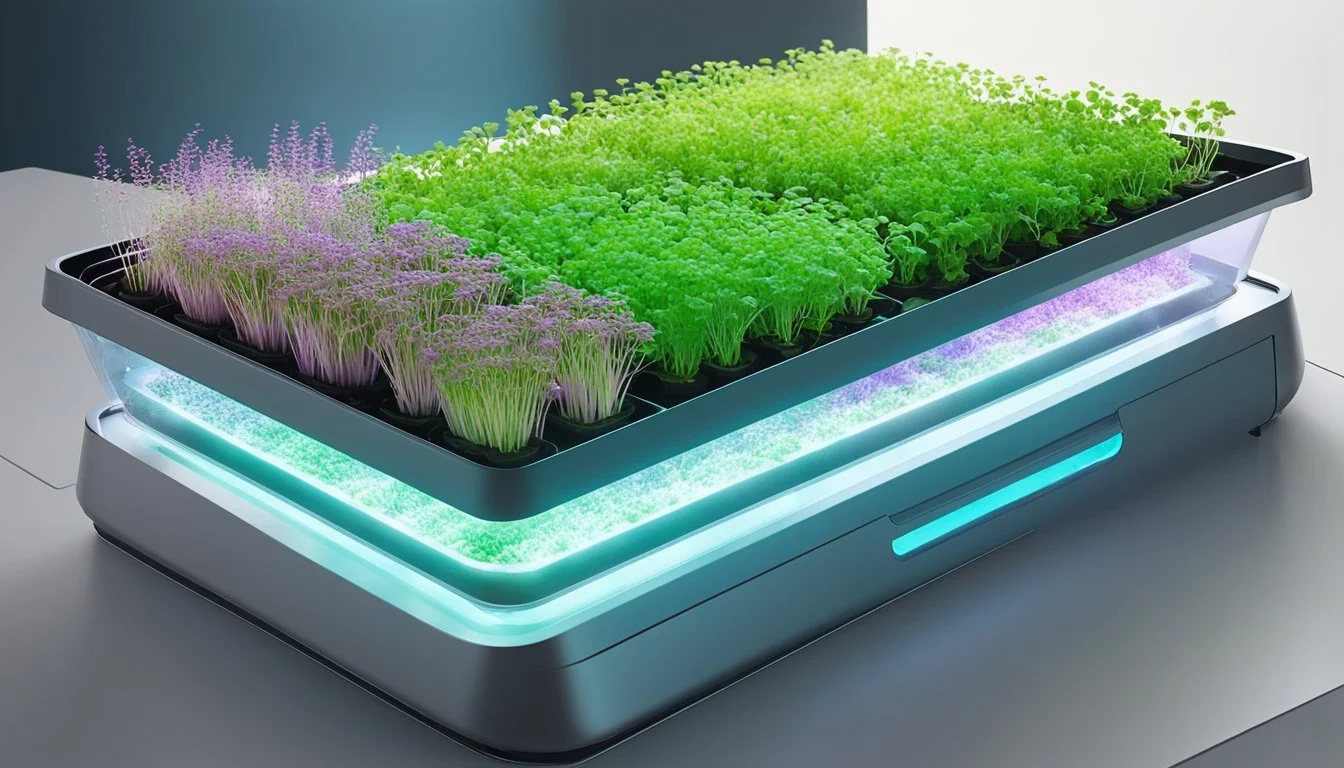Microgreens Substitutes
Top Alternatives for Your Recipes
Microgreens are a popular addition to many dishes, but what happens when they aren't available? There are plenty of substitutes that can provide a similar texture and flavor. Baby spinach, arugula, and watercress are excellent alternatives that offer a mild yet vibrant taste.
Each substitute brings unique qualities to meals. Baby spinach, for instance, has a tender texture and slightly sweet flavor, making it versatile for salads and sandwiches. Arugula, with its peppery bite, adds a zesty kick to pizzas and pastas, while watercress contributes a fresh, peppery note perfect for garnishing soups and stews.
These substitutes are not only accessible but also packed with nutrients, ensuring that any dish remains healthful and flavorful. By integrating these alternatives, one can easily replace microgreens without sacrificing taste or nutritional value.
Understanding Microgreens
Microgreens are young vegetable greens harvested just after the cotyledon leaves have fully developed, usually within 7-21 days after germination. They offer a concentrated source of nutrients and are valued for their strong flavors and varied textures.
Defining Microgreens
Microgreens are harvested shortly after the first true leaves appear. This is different from sprouts, which are harvested even earlier. Typically grown in soil or a soil substitute, microgreens need sunlight for growth. Commonly used microgreens include arugula, radish, pea shoots, and sunflowers.
Nutritional Profile of Microgreens
Microgreens are nutrient-rich, containing higher concentrations of vitamins and minerals than mature vegetables. Common nutrients found in microgreens are vitamin C, vitamin K, and beta-carotene. They also offer significant amounts of potassium, calcium, and zinc. Microgreens like kale and spinach are particularly high in antioxidants.
Health Benefits of Consuming Microgreens
Consuming microgreens provides multiple health benefits due to their high nutrient content. Antioxidants in microgreens help fight oxidative stress, which can reduce the risk of chronic diseases like heart disease and cancer. Phytochemicals found in microgreens also support the immune system. Varieties like broccoli are known for their protective effects against inflammation.
Common Varieties of Microgreens
Popular microgreens include radish, arugula, mustard greens, and beet greens. Each variety offers unique flavors and textures. Sunflower microgreens are known for their nutty taste, while watercress provides a peppery flavor. Other common types are cilantro, amaranth, lettuce, cabbage, kale, spinach, and kohlrabi. Each type has its own nutrient profile, making them a versatile addition to various dishes.
Microgreens Vs. Sprouts and Baby Greens
Microgreens, sprouts, and baby greens differ significantly in growth stages, texture, flavor, and nutritional value. Understanding these differences can aid in selecting the right substitute for your culinary needs.
Comparing Growth Stages
Microgreens are young vegetable greens harvested just after the cotyledon leaves have developed, often accompanied by the first set of true leaves. They are typically harvested 7-21 days after germination.
Sprouts, on the other hand, are germinated seeds that are usually harvested within a few days of soaking, without soil. Sprouts develop in dark, moist environments and are often consumed before leaves form.
Baby Greens are older than microgreens and are harvested later, around three weeks after germination. They are essentially young plants that have developed several sets of true leaves.
Comparing growth stages highlights that microgreens sit between the very early stage of sprouts and the more developed stage of baby greens.
Textural and Flavor Differences
Microgreens have a more complex texture and flavor compared to sprouts and baby greens. They offer a crisp texture with distinct flavors varying from peppery to mild, depending on the plant.
Sprouts possess a tender and crunchy texture, but their flavor is often milder and more uniform. They are usually eaten raw in salads or sandwiches.
Baby Greens have a more developed texture and flavor profile. Their leaves are tender yet more substantial compared to microgreens, delivering a mature taste that resembles the adult plant but is less intense.
These textural and flavor differences make microgreens suitable for adding a flavor punch, while sprouts and baby greens offer mild and tender alternatives.
Nutritional Contrast
Microgreens are rich in vitamins like A, C, and K, and minerals such as iron and magnesium. They also contain higher levels of antioxidants compared to their mature counterparts.
Sprouts are known for their easy digestibility and high nutrient availability. They are a good source of proteins, vitamins, and enzymes due to their early growth stage.
Baby Greens, due to their longer growth period, contain a balanced nutrient profile with significant amounts of fiber, vitamins, and minerals.
Overall, while microgreens are nutrient-dense, sprouts offer a quick nutrient boost, and baby greens provide a broader range of nutrients over a slightly longer period.
Growing Microgreens at Home
Growing microgreens at home can be straightforward and rewarding. By choosing the right seeds, setting up an indoor growing environment, and properly caring for your crops, you can ensure a bountiful harvest.
Selecting the Right Seeds
Choosing the appropriate seeds is crucial for successful microgreen cultivation. Some popular varieties include arugula, kale, radish, beet, and sunflower. It's essential to opt for organic seeds when possible to avoid chemical residues. Look for seeds specifically labeled for microgreens to ensure high germination rates.
Different seeds have varying growth times and flavor profiles. For example, radish seeds germinate quickly and have a spicy flavor, while sunflower seeds take longer but offer a nutty taste. Following the seed packet instructions ensures proper planting depth and spacing.
Propagating Microgreens Indoors
Microgreens thrive indoors with the right setup. Use a shallow container or growing tray and fill it with a moist growing medium like coconut coir, peat moss, or a soil substitute. Spread the seeds evenly across the surface, pressing them lightly to ensure good contact with the growing medium. Cover with another thin layer of moist medium or a damp paper towel.
Place the tray in a location with ample sunlight. A bright windowsill works well, but supplemental lighting with grow lights can improve growth in less sunny areas. Maintain a consistent temperature of around 70 degrees Fahrenheit for optimal germination.
Caring for Your Microgreens
Proper care involves consistent watering, lighting, and ventilation. Water the microgreens daily using a spray bottle to keep the growing medium moist but not waterlogged. Avoid directly soaking the seedlings to prevent mold growth. Instead, water from below by adding water to the tray and draining excess after 10-20 minutes.
Ensure the microgreens receive at least 4-6 hours of sunlight or 12-16 hours of artificial light per day. Rotate the tray periodically to ensure even light distribution and prevent bending towards the light source. Good air circulation helps prevent fungal issues and promotes healthy growth.
Harvesting Your Crop
Microgreens are ready to harvest when they reach 1-3 inches in height, usually in about 7-21 days, depending on the variety. Harvest with clean scissors or a sharp knife, cutting just above the soil line. Aim to harvest early in the day when plants are less stressed and have optimal nutritional content.
After harvesting, rinse the microgreens gently and pat them dry with a clean paper towel. Store in the refrigerator in a sealed container. Fresh microgreens can last up to a week and are a nutritious addition to salads, sandwiches, and other dishes.
Microgreens in the Kitchen
Microgreens can elevate dishes with their unique flavors and vibrant colors. They are versatile ingredients that can be used in a wide range of recipes, from soups to salads, and are rich in nutrients.
Incorporating Microgreens into Meals
Microgreens can be used both raw and cooked. When used raw, they retain their crunch and fresh taste, making them perfect for salads, sandwiches, and as a garnish. Adding microgreens to a smoothie can boost its nutrition without altering the flavor significantly. They can also be added to pasta dishes or used as a topping on pizza, bringing a burst of freshness. In soups, microgreens can be incorporated towards the end of cooking to maintain their texture and nutritional value.
Food Pairing and Flavor Combinations
Pairing microgreens with other ingredients enhances both taste and presentation. For a salad, combine microgreens with other fresh vegetables like tomatoes, cucumbers, and bell peppers. Microgreens like arugula and radish add a spicy kick to meat dishes, while milder varieties like basil or cilantro complement soups and pastas. Using them in sandwiches or wraps with avocado or cheese provides a nice balance of flavors. In a pizza with ricotta and peach, spicy microgreens can elevate the dish’s complexity.
Storing and Washing Microgreens
Proper storage is crucial to maintaining the freshness and nutrients of microgreens. Store them in a resealable plastic bag or an airtight container in the fridge. For best results, place a paper towel inside to absorb excess moisture. Washing microgreens carefully is essential to remove any soil or contaminants. Rinse them gently under cold water and use a salad spinner or pat them dry with a clean towel. This ensures they remain crisp and ready for use in various recipes.
Microgreens are not just a nutritious addition to meals but also enhance texture and flavor. Whether used in a garnish, sandwiches, or salads, they offer versatility and health benefits. Proper handling and pairing with compatible foods allow for diverse and tasty culinary creations.
Alternatives to Microgreens
Microgreens have unique flavors and nutritional benefits, but there are several other options for those who need substitutes. These alternatives can be based on availability, nutritional value, and how well they can adapt to recipes.
Substitute Options Based on Availability
When microgreens are not available, several substitutes can be used. Mature vegetables like spinach, arugula, and kale are great options. These leafy greens are common in grocery stores and can be used in a variety of dishes.
Herbs such as basil, parsley, and cilantro, though not exact replacements, can add similar vibrancy to dishes. Sprouts, including radish sprouts and alfalfa sprouts, are another good substitute, offering a slightly different texture but comparable freshness and flavor.
Comparing Nutritional Content of Substitutes
Microgreens are known for their high nutrient content, often surpassing their mature counterparts. Spinach and arugula are rich in vitamins A, C, and K, making them excellent alternatives. Kale is also a nutritional powerhouse with its high levels of calcium, potassium, and iron.
Sprouts like radish sprouts offer concentrated nutrients similar to microgreens. Herbs, such as basil and parsley, provide unique benefits; parsley is rich in vitamin K, while basil is known for its antioxidant properties. Each substitute offers a different nutritional profile, making it important to choose based on specific dietary needs.
Adapting Recipes with Microgreen Substitutes
Substituting microgreens in recipes requires attention to flavor and texture. Spinach and arugula can easily replace microgreens in salads and sandwiches due to their mild to peppery flavors. For a more robust taste, kale or watercress can be used in smoothies and garnishes.
Herbs like cilantro and parsley work well in place of microgreens in garnishes and pesto. When using sprouts such as radish sprouts, they can be added to bowls, wraps, and sushi for a fresh crunch. By selecting the right substitute, recipes can still achieve a balanced and flavorful profile.
Integrating Microgreens into a Healthy Diet
Incorporating microgreens into a healthy diet can significantly enhance nutritional intake. This section covers how to balance your diet with microgreens, the research backing their health benefits, and their bioavailable nutrient content.
Balancing Diet with Microgreens
Microgreens can be easily integrated into meals to boost their nutritional value. These small greens can enhance the taste and texture of salads, sandwiches, and smoothies.
By mixing microgreens with other vegetables, individuals can create a diverse diet rich in vitamins and minerals. Adding microgreens to meals not only provides a nutritional punch but can also help in reaching daily dietary requirements more efficiently.
Research on Microgreens and Health Outcomes
Research has shown that microgreens contain higher levels of nutrients compared to their mature counterparts. Studies indicate that microgreens are a potent source of antioxidants, which help reduce inflammation and lower the risk of chronic diseases like cancer and heart disease.
The high concentration of nutrients in microgreens supports various aspects of health, including improved gut health and better digestion. This makes them a valuable addition to a balanced diet, aiding in overall health maintenance.
Microgreens as a Source of Bioavailable Nutrients
Microgreens are packed with bioavailable nutrients, meaning the body can easily absorb and utilize them. They offer a rich source of vitamins A, C, and E, along with essential minerals such as potassium and iron.
Including microgreens in the diet ensures that these vital nutrients are readily available for bodily functions. Their high bioavailability enhances the effectiveness of nutrient absorption, supporting overall well-being.
Economic and Environmental Aspects of Microgreens
Microgreens present unique economic and environmental benefits, particularly in terms of cost-efficiency, sustainable production practices, and organic farming.
Cost-Efficiency of Growing at Home vs. Buying
Growing microgreens at home can be a cost-effective option compared to purchasing from markets. A basic setup can include seeds, growing media, trays, and a light source, which collectively are relatively inexpensive.
Initial investments might encompass around $20-$30 for seeds and materials, while recurring costs are minimal. In contrast, buying pre-grown microgreens can cost $20-$50 per pound, making home-growing a budget-friendly option over time.
Environmental Impact of Microgreen Production
Microgreen production can have a lower environmental impact than traditional agriculture. Grown efficiently in indoor environments, they use less water and minimal space, reducing agricultural footprint.
Methods like hydroponics can eliminate the need for soil, which can further reduce the use of resources. Efficient production reduces the carbon emissions linked to transportation, especially when microgreens are grown locally.
Organic Microgreens and Pesticide Use
Organic microgreens offer an eco-friendly alternative by avoiding synthetic pesticides and fertilizers. They are grown using organic seeds, natural growth mediums, and organic pest control methods.
This practice not only ensures safer consumption but also benefits the environment by reducing soil and water contamination. Pesticide-free production also appeals to health-conscious consumers, driving demand in the market.
Common Challenges and Solutions
Growing microgreens can present various problems, such as uneven germination and mold growth. Addressing these issues effectively ensures a high-quality and safe product.
Dealing with Common Growing Issues
Uneven Germination: Uneven germination often results from inconsistent watering or suboptimal growing medium. Using uniform watering techniques and a high-quality soil mix helps to ensure consistency.
Mold Growth: Poor ventilation and excessive moisture can lead to mold. Improving airflow and controlling humidity can mitigate this issue. Regularly inspecting crops allows for early detection and intervention.
Pest Management: Pests can damage microgreens, affecting yield and quality. Utilizing natural predators or organic pesticides helps manage pest issues effectively without compromising safety.
Lighting: Insufficient light affects growth rates and coloration. Supplementing natural light with grow lights ensures optimal growth conditions.
Addressing Quality and Safety Concerns
Nutrient Content: Microgreens are valued for their high nutrient density. Ensuring proper soil quality and fertilization practices maintains their nutritional value.
Water Quality: Using clean, filtered water prevents contamination. This is crucial for maintaining both the health of the plants and the safety of the consumer.
Harvesting Practices: Handling microgreens delicately during harvest minimizes damage. Sanitizing tools before use prevents the introduction of pathogens.
Storage: Proper storage conditions are necessary to maintain freshness and safety. Microgreens should be stored in a cool, dry place to extend shelf life and reduce spoilage risk.
Ensuring high-quality and safe microgreens involves tackling issues in growing, pest management, and post-harvest handling. Following best practices helps to deliver a product that meets both consumer expectations and regulatory standards.
Future of Microgreens
The future of microgreens looks promising, driven by innovations in farming techniques, increasing adoption in commercial food industries, and ongoing research into their health benefits and applications.
Innovations in Microgreen Farming
Innovations in farming technology are revolutionizing microgreen production. Hydroponics and vertical farming have become pivotal, allowing for high-density production in urban environments. These methods reduce water usage and space requirements, making them more sustainable and cost-effective. Automation and advanced lighting systems further optimize growth conditions, enhancing yield and nutritional quality.
Additionally, developments in genetic research facilitate the cultivation of microgreens with enhanced traits, such as improved flavor profiles and higher nutrient concentrations. These continuous advancements are vital for meeting the rising demand for microgreens and maximizing their agricultural efficiency.
Microgreens in Commercial Food Industries
Microgreens are increasingly being integrated into the commercial food industry. Restaurants and food service providers are adopting microgreens to enhance menu offerings, capitalizing on their aesthetic appeal and nutritional benefits. Pre-packaged microgreen products are becoming more prevalent in grocery stores, catering to health-conscious consumers seeking convenient, nutrient-dense food options.
In the beverage industry, microgreen-based juices and smoothies are emerging as popular choices. The commercial sector is also exploring their use in functional foods, where microgreens can add value through their bioactive compounds. These trends reflect a growing recognition of microgreens as versatile and desirable ingredients in multiple food segments.
Research Directions and Potential Discoveries
Ongoing research is expanding the scope of knowledge about microgreens. Scientists are investigating the specific health benefits linked to different microgreen varieties, including their potential to fight chronic diseases. Research into bioactive molecules aims to identify compounds with antioxidant, anti-inflammatory, and antimicrobial properties.
Exploring sustainable cultivation methods, such as utilizing agricultural by-products as growing media, is another key area of focus. Potential discoveries may lead to the development of new microgreen varieties with unique health benefits or tailored nutritional content. These research directions not only enhance understanding but also drive future innovations and applications.





